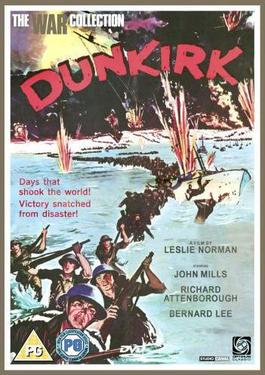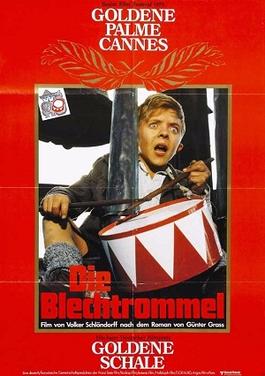Hey gang, I finally got a copy of "Dunkirk" and it was worth the wait.
BACK-STORY: “Dunkirk” is a war movie about the famous “miracle” evacuation of the British Expeditionary Force from France during the German invasion of 1940. It was released in 1958 and is a British black and white film directed by Leslie Norman. It is based on the novel The Big Pick-Up by Elleston Trevor and the book by Lt. Col. Evan Butler and Maj. J.S. Bradford.
OPENING: The movie opens as though you are in a WWII movie theater replete with the newsreel showing Prime Minister Chamberlain meeting with the French government during the “Phony War” and a cartoon making fun of Hitler. It is apparent that the British public is not taking the war seriously and the government and military are not prepared for the onslaught. We meet cynical reporter Charles Foreman (Bernard Lee) as he questions the veracity of military reports. His counterpoint is John Holden (a milquetoast Richard Attenborough) who brags about how much his business is making off of war orders. He has every intention of avoiding active involvement in the war.
SUMMARY: A small squad of British soldiers is lost and on the run in the chaos surrounding the invasion of France. They are trying to find their unit. When their commanding officer is killed, Cpl. “Tubby” Binns (John Mills) reluctantly takes over. He is the stereotypical enlisted man who doesn’t want “the stripes”. He and his four men pass through a line of refugees which is promptly strafed with the usual “it sucks to be a civilian” results. They hook up with an artillery battery and barely move on before Stukas arrive to destroy this finger in the dike.
There is time to take refuge in a farmhouse and get a nice night’s rest including a meal of eggs and stale bread. These are not super soldiers so they get surprised by an early morning German attack that sends them spilling out the back door and results in Binns having to make the tough decision to leave a wounded man behind. Being a leader is tougher than being a follower. His back-slapping mates are now less than thrilled with him.
Meanwhile back on the home front, Operation Dynamo has commenced with the British government confiscating private boats for the evacuation of soldiers trapped at Dunkirk. Holden is confident he will not be affected because his boat is six inches too short, but even after his wife begs him to stay home “for me and the baby”, he is shamed by Foreman into donating his boat. When the boatmen witness the returning wounded, Foreman leads them in demanding the Royal Navy allow them to participate. Under peer pressure, Holden agrees to go. Their little motley flotilla crosses the English Channel to stirring music.
Back at the front there is a crisis in command when Binns insists the men move on, but they want to lounge around in a barn until the Germans arrive. Tubby is going to throw his hands up when his friend convinces him that being a horse’s arse is part of British leadership and he forces them to move. Too late. There are Jerries everywhere, but they cheekily walk right through their camp (with the aid of a distracting air raid) and then make a run for it (they do a lot more running than fighting in the movie) until they are picked up by a British truck that takes them to Dunkirk.
Although newcomers to this evacuation, our heroes quickly get to the front of the line for evacuation via a destroyer. Unfortunately, almost as soon as they are on board the ship is hit and set afire. The ship sinks (using footage from “The Cruel Sea”) and they are now back on the beach which is periodically bombed by the Luftwaffe.
Our two story lines intersect when Foreman’s boat gets sunk and Holden picks him up. The Heron develops engine trouble and guess which group has a mechanic that can help? This will take time, giving Foreman a chance to see what it’s like on the beach and to explain to Blinns how fouled up the war effort is. “The Germans knew war was guns or butter. They chose guns, we chose butter.” And it’s not a stick of butter than kills him. “Was he a civvie?” someone asks Binns. “What’s the difference?” retorts Tubby.
CLOSING: The survivors leave in the Heron, but when it breaks down it looks like they are Calais bound via the tide. The cavalry, I mean British navy, comes riding to the rescue and soon its home sweet home to fight another day.
RATINGS:
Action - 7
Acting – 8
Accuracy – 8
Realism – 7
Plot – 7
Overall – 7
WOULD CHICKS DIG IT? Yes. The cast is strong, although there are no significant roles for women and one of them is a the stereotypical “put me before your country” type. The violence is noisy, but not graphic. There is no blood. Strafing does not even result in bullet holes. The home front gets equal billing with the battle front.
ACCURACY: The movie is pretty true to the facts. It glosses over the big picture, but the vibe is basically accurate. England was woefully ill-prepared both materially and mentally for the war. The movie begins in the “Phoney War” period before the German barged into France. Other than the rare Charles Foreman (none of the main characters are real), most Brits were clueless that a storm was about to hit. In fact, there was a bizarre overconfidence symbolized in the movie when we see the singing of “Hang Out the Washing on the Siegfried Line” in a music hall juxtaposed with an animated map showing Germany engulfing northeastern France and encircling Dunkirk.
Operation Dynamo is accurately depicted although the big picture is vague. I assume the filmmakers assumed the audience was well aware of the history. Boats were rounded up and many civilians did participate. Several destroyers were lost to the point that the Admiralty pulled them out temporarily until Vice Admiral Ramsey insisted on risking them. (A scene that appears in the film.) The lining up of the men on the beaches and the pier are true to the situation. However, the wooden pier that gets bombed with men falling into the water was in actuality a rather substantial stone pier.
Two of the biggest inaccuracies are more along the lines of omissions. At one point in the film, a RAF pilot who was shot down and is now on the beach with the soldiers takes a lot of grief for his branch’s lack of effort. He lamely blames it on the lack of squadrons, but leaves the RAF on the hook for not protecting the beaches. In reality, the RAF put out an outstanding effort in the skies over Dunkirk. The problem was much of the dogfighting could not be seen by the soldiers and thus went uncredited. It is perplexing why a British filmmaker would perpetuate this canard.
The other omission is the virtual exclusion of the French role in Dunkirk. The fact is that French army forces played a sacrificial role in holding back the Germans long enough for most of the British (and it must be said, many French to escape). It seems this fact could have easily slipped into the script.
CRITIQUE: “Dunkirk” is an above average war movie. It attempts to blend two stories and is successful. Foreman and Holden represent the two attitudes on the home front - the cynical, pessimistic patriot and the naïve appeaser. The movie is actually pretty critical of the British public during the “Phony War”. Holden is not meant to be a rarity. In fact, Foreman is the lone voice in the wilderness. Foreman is a bit preachy, but the movie is not blatantly patriotic. And by the way, what is he preaching about? The war has been over for thirteen years. You don’t suppose he is envisioning the Cold War, do you?
The soldier story is reflected in Binns. He is meant to be a typical enlisted man and comes off as one. This includes his reluctance to accept the mantle of command. He is given little back story, but his character is fleshed out by the pressures he endures. This is more than can be said about the other members of his squad. We don’t get to know them very well. One of them talks like a girl, but that’s the only thing memorable about them.
Binns offers a study in command. He evolves into a strong leader, but it’s a rocky road. He is mostly to blame for them getting caught with their pants down in the farmhouse (although I doubt the movie was trying to make this point). He makes the right decision to leave the wounded guy behind and he probably would have been on the other side of the argument if he was still one of the blokes. His big scene comes when the men rebel against moving on in the night. At first he wimps out, but then he grows a pair and accepts the hatred that goes with the stripes. (A typical movie scene that defies logic to make a plot point – those soldiers would have taken no convincing to keep ahead of the Germans.)
The two stories intersect inevitably because this is a movie, after all. It’s amazing that for the first half of the movie, Binns’ group is wandering confused and lost in a big world and then in the last part it becomes a simple and small world where they can hook up with Foreman and Holden.
Technically speaking, the movie is very good. It blends archival footage well, but not seamlessly. However, I’d rather have blurry Stukas over CGI Stukas any time. The movie has some of the best air and artillery bombardments on film. Those look and sound like real explosions. And we get a lot of them. Every time you look up, they’re getting bombed or strafed. The beach set is impressive. Lots of extras to run when the Luftwaffe appears. The score is stirring and not overused.
CONCLUSION: This movie is a classic, old school war movie. It is not great, but it does its job efficiently. The acting is appropriate and you will recognize many familiar faces (hey, that’s James Bonds’ boss!). It’s a comfortable movie that breaks no new ground. However, it deserves credit for calling out incompetence in the government and military and criticizing the British people for their behavior before the invasion of France.



